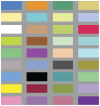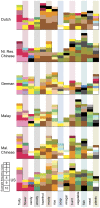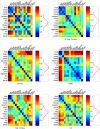Cross-cultural color-odor associations
- PMID: 25007343
- PMCID: PMC4089998
- DOI: 10.1371/journal.pone.0101651
Cross-cultural color-odor associations
Abstract
Colors and odors are associated; for instance, people typically match the smell of strawberries to the color pink or red. These associations are forms of crossmodal correspondences. Recently, there has been discussion about the extent to which these correspondences arise for structural reasons (i.e., an inherent mapping between color and odor), statistical reasons (i.e., covariance in experience), and/or semantically-mediated reasons (i.e., stemming from language). The present study probed this question by testing color-odor correspondences in 6 different cultural groups (Dutch, Netherlands-residing-Chinese, German, Malay, Malaysian-Chinese, and US residents), using the same set of 14 odors and asking participants to make congruent and incongruent color choices for each odor. We found consistent patterns in color choices for each odor within each culture, showing that participants were making non-random color-odor matches. We used representational dissimilarity analysis to probe for variations in the patterns of color-odor associations across cultures; we found that US and German participants had the most similar patterns of associations, followed by German and Malay participants. The largest group differences were between Malay and Netherlands-resident Chinese participants and between Dutch and Malaysian-Chinese participants. We conclude that culture plays a role in color-odor crossmodal associations, which likely arise, at least in part, through experience.
Conflict of interest statement
Figures




References
-
- Zellner DA, Bartoli AM, Eckard R (1991) Influence of color on odor identification and liking ratings. Am J Psychol 104: 547–561. - PubMed
-
- Gilbert AN, Martin R, Kemp SE (1996) Cross-modal correspondence between vision and olfaction: the color of smells. Am J Psychol 109: 335–351. - PubMed
-
- Schifferstein HNJ, Tanudjaja I (2004) Visualising fragrances through colours: the mediating role of emotions. Perception 33: 1249–1266. - PubMed
-
- Demattè ML, Sanabria D, Spence C (2006) Cross-modal associations between odors and colors. Chem Senses 31: 531–538. - PubMed
-
- Maric Y, Jacquot M (2013) Contribution to understanding odour–colour associations. Food Qual Prefer 27: 191–195.
Publication types
MeSH terms
LinkOut - more resources
Full Text Sources
Other Literature Sources

